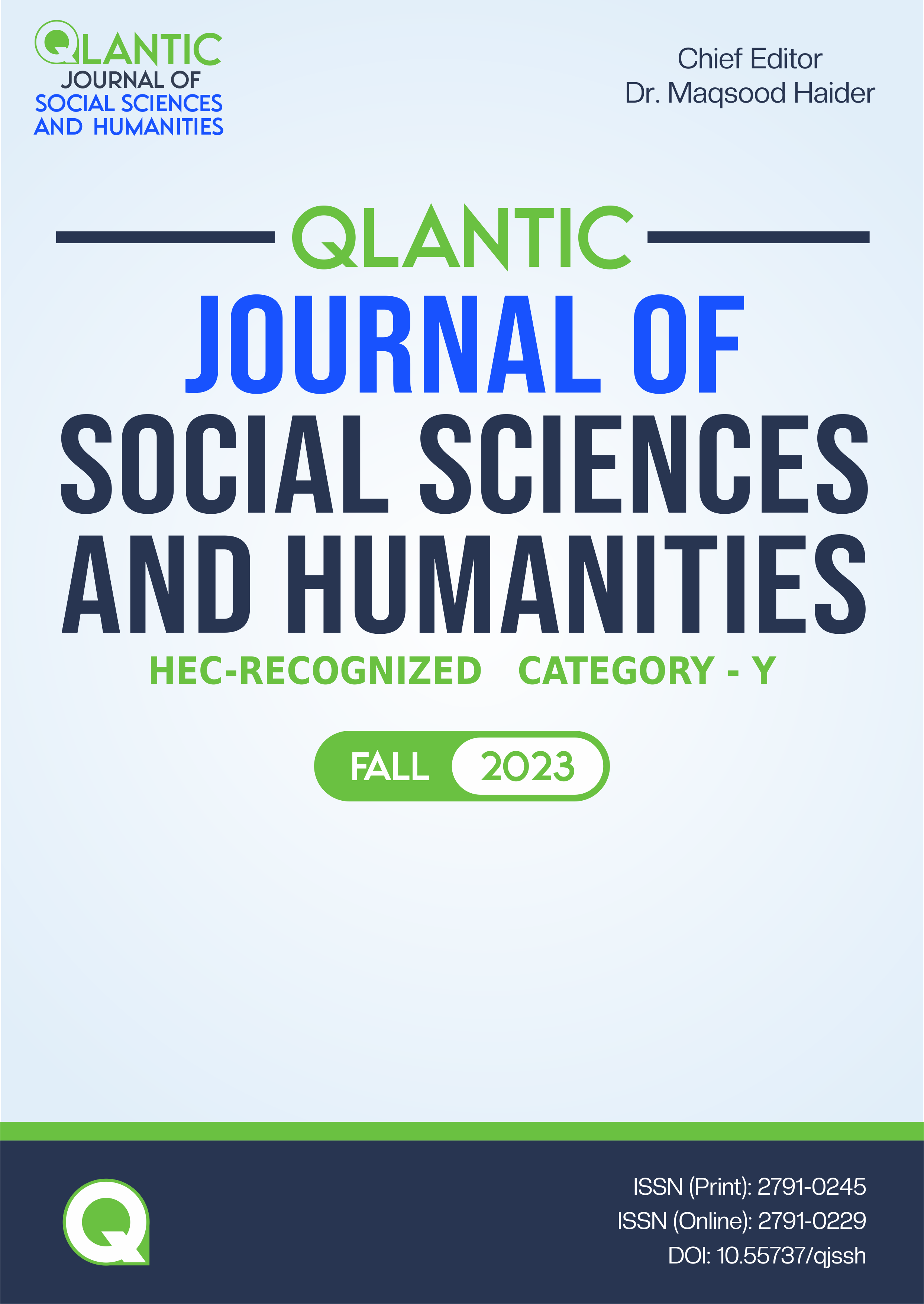Husbands’ Migration and the Left-behind Wives: The Psychosocial Impacts on Life Experiences of the Women of District Quetta, Pakistan
DOI:
https://doi.org/10.55737/qjssh.131186964Keywords:
Husband’s Migration, Left-behind Wives, Psychosocial Impacts, Life ExperienceAbstract
Migration has always been a focus of social scientists for many reasons, especially its impacts on the families of those who migrate for a long period of time. The recent literature reveals that migration can have both pros and cons. Keeping in view the existing facts and figures, this research study was designed to explore the psycho-social impacts on the migrants’ families, especially their wives, as they take the primary responsibilities of their families after their husbands’ migration. The researchers used the qualitative method by using open-ended interviews for data collection and thematic analysis. It is explored that a husband’s migration has certain impacts on the left behind wives, such as distress, fear, disparities, insecurity, negative rumors, problems in movement, threats from in-laws and neighbors, and treatment as a laborer. Based on the study findings, it is recommended that left behind wives have many psychosocial barriers; hence, the government may provide emotional support to the migrants’ families in terms of their children’s education, health, and socialization and the other family members, such as in-laws may also take care of their children and socialize and reasonably treat them.
References
Asis, M. M., Huang, S., & Yeoh, B. S. (2004). When the light of the home is abroad: Unskilled female migration and the Filipino family. Singapore Journal of Tropical Geography, 25(2), 198-215. https://doi.org/10.1111/j.0129-7619.2004.00182.x
Attride-Stirling, J. (2001). Thematic networks: An analytic tool for qualitative research. Qualitative Research, 1(3), 385-405. https://doi.org/10.1177/146879410100100307
Buch, C. M., & Kuckulenz, A. (2010). Worker remittances and capital flows to developing countries. International Migration, 48(5), 89-117. https://doi.org/10.1111/j.1468-2435.2009.00543.x
Compernolle. E., L. (2017). Spouses Crossing Borders: Husbands’ International Migration and the Marital Relationship. Unpublished Dissertation of Doctor of Philosophy Sociology. University of Michigan
Conway, D., & Cohen, J. H. (1998). Consequences of migration and remittances for Mexican transnational communities. Economic Geography, 74(1), 26-44. https://doi.org/10.2307/144342
De Haas, H. (2007). Morocco's migration experience: A transitional Perspective1. International Migration, 45(4), 39-70. https://doi.org/10.1111/j.1468-2435.2007.00419.x
Durand, J., & Massey, D. S. (1992). Mexican migration to the United States: A critical review. Latin American Research Review, 27(2), 3-42. https://doi.org/10.1017/s0023879100016770
Durand, J., Kandel, W., Parrado, E. A., & Massey, D. S. (1996). International migration and development in Mexican communities. Demography, 33(2), 249-264. https://doi.org/10.2307/2061875
Farooq, M., & Javed, Z. H. (2009). The impact of international migration on migrants’ families left behind in the rural area of Pakistan. Pak. J. Agri. Sci, 46(4), 233-236. https://www.pakjas.com.pk/papers/73.pdf
Hoang, L. A., & Yeoh, B. S. (2011). Breadwinning wives and “left-behind” husbands: Men and masculinities in the Vietnamese transnational family. Gender & Society, 25(6), 717-739. https://doi.org/10.1177/0891243211430636
Javed, Z., & Farooq, M. (2009). Economic growth and exchange rate volatility in the case of Pakistan. Pakistan Journal of life and social sciences, 7(2), 112-118. https://pjlss.edu.pk/pdf_files/2009_2/3.pdf
Jokisch, B., & Pribilsky, J. (2002). The panic to leave: Economic crisis and the “New emigration” from Ecuador. International Migration, 40(4), 75-102. https://doi.org/10.1111/1468-2435.00206
Jurado, D., Alarcón, R. D., Martínez-Ortega, J. M., Mendieta-Marichal, Y., Gutiérrez-Rojas, L., & Gurpegui, M. (2017). Factors associated with psychological distress or common mental disorders in migrant populations across the world. Revista de Psiquiatría y Salud Mental (English Edition), 10(1), 45-58. https://doi.org/10.1016/j.rpsmen.2017.02.004
Kollmair, M., Manandhar, S., Subedi, B., & Thieme, S. (2006). New figures for old stories: Migration and remittances in Nepal. MIGRATION LETTERS, 3(2), 151-160. https://doi.org/10.33182/ml.v3i2.66
Lee, H., & Tupai Francis, S. (2009). Migration and transnationalism: Pacific perspectives (p. 230). ANU Press.
Levitt, P. (1998). Social remittances: Migration driven local-level forms of cultural diffusion. International Migration Review, 32(4), 926-948. https://doi.org/10.1177/019791839803200404
Mahler, S. J., & Pessar, P. R. (2006). Gender matters: Ethnographers bring gender from the periphery toward the core of migration studies. International Migration Review, 40(1), 27-63. https://doi.org/10.1111/j.1747-7379.2006.00002.x
Maskay, N. M., & Subedi, S. R. (2009). Development of the Nepalese financial system: Need for the formulation of a master plan. NRB Economic Review, 31-51. https://doi.org/10.3126/nrber.v21i1.52803
Oppong, N. Y. (2013). Construction and application of conceptual framework as research tool: A researcher’s reflections. Research on Humanities and Social Sciences, 3(13), 30-41. https://core.ac.uk/download/pdf/234673606.pdf
Palys, T. (2008). Basic research. The Sage encyclopedia of qualitative research methods, 2, 58-60.
Pessar, P. R. (2001). 9. Dominicans: Transnational Identities and Local Politics. In New Immigrants in New York (pp. 251-274). Columbia University Press.
Radel, C., Schmook, B., & Méndez, C. (2014). Gender, the household, and land change in southeastern Mexico. In Land Change Science, Political Ecology, and Sustainability (pp. 107-128). Routledge.
Schmook, B., & Radel, C. (2008). International labor migration from a tropical development frontier: Globalizing households and an incipient forest transition. Human Ecology, 36(6), 891-908. https://doi.org/10.1007/s10745-008-9207-0
Shakya, H. B., Christakis, N. A., & Fowler, J. H. (2014). Association between social network communities and health behavior: An observational Sociocentric network study of latrine ownership in rural India. American Journal of Public Health, 104(5), 930-937. https://doi.org/10.2105/ajph.2013.301811
Venkataraman, S. T., & Gulati, S. (1992). Control of nonlinear systems using terminal sliding modes. 1992 American Control Conference. https://doi.org/10.23919/acc.1992.4792209
Williams, N. E. (2009). Education, gender, and migration in the context of social change. Social Science Research, 38(4), 883–896. https://doi.org/10.1016/j.ssresearch.2009.04.005
Yabiku, S. T., Agadjanian, V., & Sevoyan, A. (2010). Husbands' labour migration and wives' autonomy, Mozambique 2000–2006. Population Studies, 64(3), 293-306. https://doi.org/10.1080/00324728.2010.510200
Published
Issue
Section
License
Copyright (c) 2023 Erum Hussain, Jan Alam, Tariq Aziz

This work is licensed under a Creative Commons Attribution-NonCommercial 4.0 International License.





